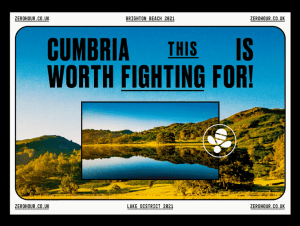It seems that right now, graphic design is helping to shape social, environmental and cultural change. So does it follow that designers are better equipped than many other professions when it comes to offering solutions to some of the most pressing issues facing our planet? Can shape, line, colour and space really change the world? We examined the evidence…
Whether we’re aware of it or not, graphic design surrounds us. It can be found in the tiniest of places. The book on the table. The poster on the wall. The website you’re browsing. All of these things have been carefully and thoughtfully executed by a designer.
In fact, graphic design has well and truly infiltrated every aspect of our life and it would be almost impossible to get through a day without seeing some element of it somewhere.
But, while good design may be an art in and of itself, the role of the graphic designer isn’t to just create an attractive picture or decorate a space – increasingly they have a much larger social responsibility.
In fact, they may just be better equipped than any other profession when it comes to offering solutions to some of the most pressing issues facing our planet today.
Designing a better planet
At its very heart, the job of graphic design is to make information digestible and enticing, no matter how complex or emotive it may be.
Take the current environmental situation for example. Designers around the world have a big part to play in helping the public to understand the often daunting statistics that surround it – from rising temperature and sea levels to the number and type of species and habitats becoming extinct.
The role of graphic design doesn’t end at breaking down arguments visually though – it can also be used as a way to educate people on how they will individually and collectively be impacted by climate change.
Take the WWF for example. Famous around the world for it’s often shocking adverts, the charity uses originality and (sometimes) subtlety to teach the public about the very real dangers facing us and our natural world.
It isn’t all about negativity though; organisations are also very happy to use optimism to get their message across. In Zero Hour’s 2020 campaign to pass the Climate and Ecological Emergency Bill (CEE Bill) which has since been updated this June (2022), the team used positive messaging to remind prospective voters what they’re fighting to preserve.
The inspiring messaging coupled with beautifully designed photograph collages of UK landscapes really packs a punch. Zero Hour’s bee-meets-exclamation point logo design is also brimming with meaning. The environmentally symbolic bee combined with the exclamation represents both what the fight is for (similar to the countryside imagery) and the urgency behind the movement.

Image courtesy of Creative Boom.
The psychology of design
Graphic design isn’t purely about communicating the ‘big issues” though. At a more micro level, it influences and reinforces our loyalty to the products we buy, the places we shop and even things we eat. And all that’s done through the use of a couple of key cues.
Colour
As humans, we associate different colours with specific feelings or thoughts. Blue, for example, is used to convey a sense of trustworthiness, which is why it’s so popular with corporations like Facebook.
Green signifies freshness and growth, and is perfect for companies like Whole Foods who want to highlight their connection to the natural world.
Red on the other hand is the colour of energy, love and action, and works perfectly for companies who want to communicate excitement and energy, like Coca-Cola,
Shapes
Just like colours, we associate different shapes with certain emotions and characteristics.
Circles, ovals, and ellipses, for instance, are intrinsically linked to community, friendship and love, which is why they’re so popular with communications companies like AT&T.
Squares and triangles meanwhile symbolise balance and strength, and help brands like Microsoft to establish feelings of stability and efficiency amongst consumers.
Vertical lines signify masculinity, strength, and aggression, while horizontal lines suggest tranquillity, and calm, making them the perfect choice for charities like the Human Rights Campaign.
The world is waiting
Considering its almost universal presence, it should come as little surprise, then, that graphic design can have such a wide-reaching impact, not just on us as individuals, but our society and our planet.
If you’d like to chat more about the importance of graphic design and how it can be used to transform the world, please just drop us a line at sim@sim7creative.co.uk. Until then, thanks for reading.



